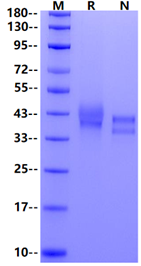Gly30-Trp344, with C-terminal 8*His GNCWLRQAKNGRCQVLYKTELSKEECCSTGRLSTSWTEEDVNDNTLFKWMIFNGGAPNCIPCKETCENVDCGPGKKCRMNKKNKPRCVCAPDCSNITWKGPVCGLDGKTYRNECALLKARCKEQPELEVQYQGRCKKTCRDVFCPGSSTCVVDQTNNAYCVTCNRICPEPASSEQYLCGNDGVTYSSACHLRKATCLLGRSIGLAYEGKCIKAKSCEDIQCTGGKKCLWDFKVGRGRCSLCDELCPDSKSDEPVCASDNATYASECAMKEAACSSGVLLEVKHSGSCNSISEDTEEEEEDEDQDYSFPISSILEWGGGSHHHHHHHH
1. Paul T Fullerton Jr, Diana Monsivais. Follistatin is critical for mouse uterine receptivity and decidualization. Proc Natl Acad Sci U S A. 2017 Jun 13;114(24): E4772-E4781. Epub 2017 May 30.
Follistatin (FST) is a regulator of TGFβ family signaling and acts by selectively binding to TGFβ family ligands and preventing ligand binding to the receptor complex. There are two major isoforms of FST, FST288, which is anchored to the cell surface by interactions with heparin sulfate proteoglycans, and FST315, which is the predominant form found in circulation. In humans, aberrant expression of FST and activins are implicated in infertility; dysregulation of FST, activins, and inhibins was reported in women with impending abortion, recurrent miscarriage, hypertensive disorders during pregnancy, and repeated implantation failure after in vitro fertilization. However, the role that FST plays in normal pregnancy remains uncertain.

1μg (R: reducing condition, N: non-reducing condition).